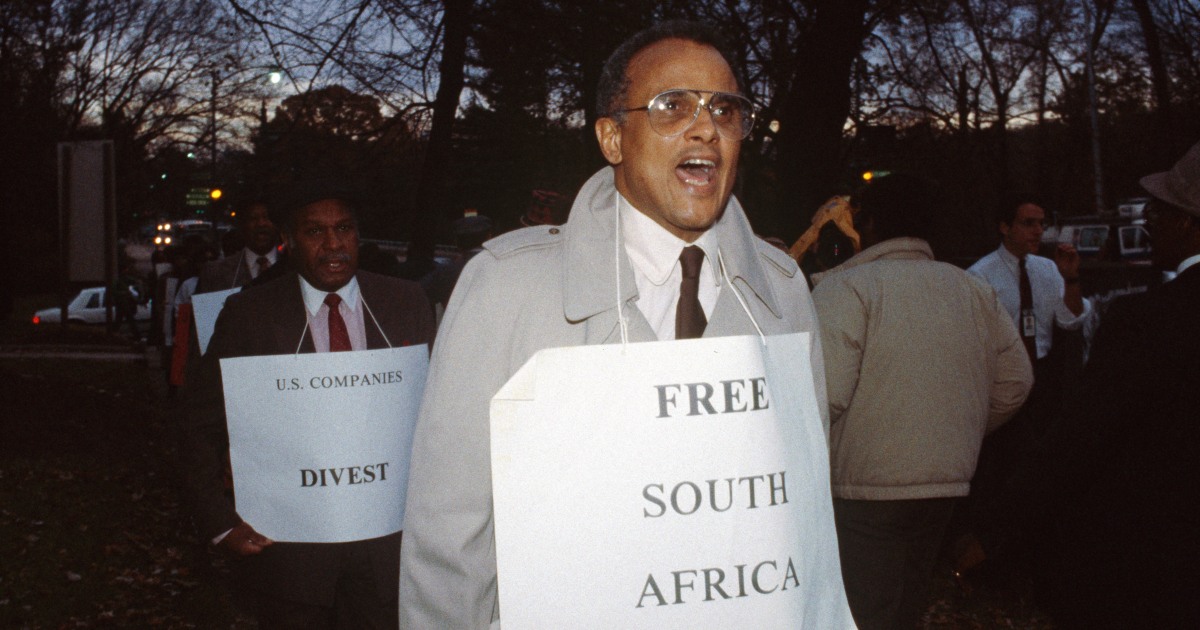At the height of his storied entertainment career that spanned more than 70 years, Harry Belafonte risked everything for the good of black people. Onstage or in the background, Belafonte supported the Civil Rights Movement in multiple ways, understanding that his involvement would impact his professional endeavors.
He did not care.
One of the many elements of Belafonte’s legacy, following his death Tuesday at age 96, is that he always seemed to put his people first.
“He really was one of the first artists, actors who seamlessly fused social justice into his work,” said Imani Cheers, an associate professor of media and public affairs at George Washington University in Washington, D.C. “It wasn’t an afterthought. It was a part of him with his work in film and music ”.
Cheers said Belafonte’s activism is doubly impressive compared to today, when “activism is seen as something that can be a ‘like’ on a social media post,” he said. “It’s like if you get involved and go to a protest or rally and say, ‘I’ve done my part,’ and then they don’t need to be involved in the movement in more meaningful ways.”
«Harry Belafonte really showed and modeled how to literally live the path and walk in ways that we’ve never seen before… But I pray we see it again,» Cheers said.
Belafonte, who died of congestive heart failure, developed a close relationship with Martin Luther King, the iconic civil rights leader, and became immersed in the fight for civil rights. He refused to perform in the South from 1954 to 1961, which exposed him to being blacklisted by Hollywood during the McCarthy era and targeted by racists. He didn’t stop him.
He often marched with King and others. And the impact of him was also felt behind the scenes. Belafonte became a key fundraiser for the Civil Rights Movement, according to the King Center. When King was arrested in Birmingham, Alabama, with other activists in 1963, the artist raised $50,000 (nearly $500,000 in today’s dollars, according to the Bureau of Labor Statistics) to free the group from jail. He later rounded up a number of other artists, including Marlon Brando, Paul Newman, and Tony Bennett, to get involved in the movement.
He engaged with presidents from John F. Kennedy to Barack Obama, pressing them to have a sense of purpose and urgency in addressing black needs. When the first black president asked Belafonte to «give him some slack,» Belafonte responded, «What makes you think that’s not what I’ve been doing?»
Belafonte’s militancy spread to Africa, where he visited frequently, especially Kenya. He was a staunch activist against apartheid in South Africa. “Paradise in Gazankulu”, his last album, released in 1988, deals with the plight of South Africans living under apartheid. He partnered with South African artists to tell the story of the oppression faced by black South Africans.
Even his music, he sang mostly calypso, served that purpose. belafonte said in 1993 to The New York Times that he used his songs «to describe the human condition and give people an idea of what may be happening globally, based on what I’ve experienced.»
A dozen years earlier, he said that his dedication to the fight because equality was unbreakable. “I fully believed in the Civil Rights Movement,” he told the New York Times. in 1981. «I had a personal commitment to that and I had my personal breakthroughs: I produced the first Black TV special; I was the first black to perform at the Waldorf Astoria. I felt if we could change the nation, things would fall apart.» instead.»
But it didn’t work that way. Racism persisted, and so did Belafonte.
He also encouraged new generations of black artists to assume their social responsibilities, advising Usher, Common, and others while also scolding some like Jay-Z and Beyoncé for not entering the fray in over a decade.
“It’s really important that the younger generation who might not be familiar with his movies or his music really understand the way that he was so dedicated to what people now call the causes,” Cheers said. “He was at almost every high point in the history of civil rights for people of color in this country. And he was at the forefront, but more importantly, what I think is really beautiful is that a lot of his most significant work was in the background.»
That background work included strategizing with leaders, providing financial support and lending his house “as a place of strategy, as a place of refuge, as a peaceful resting place for these civil rights leaders,” Cheers said. “And the way he also extended his friendship and his brotherhood and his love to so many of our fallen comrades and leaders in the fight for justice for all people, but really focusing on justice for Black people in this country.”

